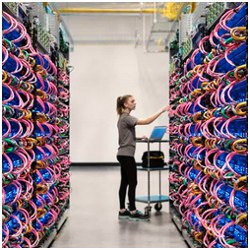The latest paper by David Patterson & Google TPU team reveals details of the world most efficient and one of the most powerful supercomputers for DNN Acceleration - TPU v3. The one which was used to train BERT.
We recommend that you definitely read the full text, but here are insights and tldr highlights
Key Insight:
The co-design of an ML-specific programming system (TensorFlow), compiler (XLA), architecture (TPU), floating-point arithmetic (Brain float16), interconnect (ICI), and chip (TPUv2/v3) let production ML applications scale at 96%–99% of perfect linear speedup and 10x gains in performance/ Watt over the most efficient general-purpose supercomputers.
More highlights:
🐣🐤🐔 Three generations
There are 3 generations of TPU now released, TPU v1 used fixpoint arithmetic and was used for inference only. TPU v2 and v3 operate in floating-point and used for training. TPU v4 results were presented in MLPerf summer release, but there is no public information available. The TPU architecture differs from CPU with
▪️ Two Dimensional array processing units (instead of 1D vector SIMDs in CPU)
▪️Narrower data (8-16 bits)
▪️ Drop complex CPU features - caches and branch prediction
🐮🤜🐤 Fewer cores per chip (two oxen vs 1024 chickens)
NVidia put thousands of CUDA cores inside their chip. TPU v3 has only 2 TensorCores per chip. It's way easier to generate a program for 2 beefier cores than to swarm of wimpier cores.
Each TensorCore includes the following units:-
▪️ICI(Inter Core Interconnects) - connect core across different chips-
▪️HBM, stacked DRAM on the same interposes substrate-
▪️Core Sequencer - manages instructions and performs scalar operations-
▪️Vector Processing Unit, performs vectors operation for 1D and 2D vectors-
▪️Matrix Multiply Unit (MXU)
🐱🐶❓ From inference to training chip
Key challenges on the way from inference chip V1 to training hardware V2
▪️ Harder parallelization
▪️ More computation
▪️ More memory
▪️ More programmability
▪️ Wider dynamic range of data
✂️🧮✂️ Brain FloatIEEE FP16 and FP32 use (1+8+23) and (1+5+7) bits for the sign, exponent, and mantissa values respectively. In practice, DNN doesn't need mantissa precision of FP32, but the dynamic range of FP16 is not enough. Using of FP16 also requires loss scaling.
The compromised bf16 keeps the same 8 bits for exponent, as FP32, but reduced mantissa - only 7 bits instead of 23. BF16 delivers reducing space usage and power consumption with no loss scaling in software required.
🍩🧬⚡️ Torus topology and ICI
TPU v1 was an accelerator card for CPU 'based computer. TPUv2 and v3 are building blocks of the supercomputer. Chips connected with ICI interface, each running at ~500Gbits/s. ICU enables direct connection between chips, so no need of any extra interfaces. GPU/CPU based supercomputers have to apply NVLink and PCI-E inside computer chase and InfiniBand network and switches to connect them.
Chips in TPUv2 and v3 clusters are connected in 2D Torus topology (doughnut ) and achieve an unbelievable linear scale of performance growth with increasing of chips number.
🛠⚙️🖥 XLA compiler (to orchestrate them all)
TF programs are graphs of operations, where tensor-arrays are first-class citizens. XLA compiler front-end transforms the TF graph into an intermediate representation, which is then efficiently mapped into selected TPU (or CPU/GPU) architectures. XLA maps TF graph parallelism across hundreds of chips, TensorCores per chip, multiple units per core. XLA provides precise reasoning about memory use at every point in the program.
Young XLA compiler has more opportunities to improve than a more mature CUDA stack.
🌲🐰🦊 Green Power (Forest animals approves)
TPU v3 supercomputer already climbed on the 4th row of TOP500 ranking, but what is remarkable - it demonstrates an overwhelming 146.3 GFLops/Watt performance. The nearest competitor has 10 times and lower number.
Original Paper
A Domain Specific Computer for training DNN
>>Click here to continue<<

